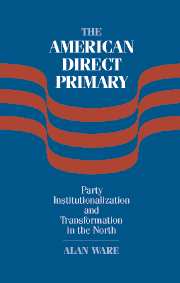8 - Reaction and Aftermath
Published online by Cambridge University Press: 16 July 2009
Summary
By the end of 1915, the direct primary had become the most widely employed nominating system in the United States. All but three states (Connecticut, New Mexico, and Rhode Island) used it for selecting candidates to at least some elective offices. Most of these forty-five states nominated virtually all offices in this way – 78 percent of states in the east and 95 percent of western states did so. In an obvious sense, candidate selection had been transformed. But how much had actually changed, and how much of the change that there had been could be attributed to the impact of direct nominations? These are questions that are addressed in the middle of this chapter. Following that, we consider the adoption of the presidential primary, and its relation to the direct primary. First, however, attention will be paid to a matter that was largely forgotten toward the end of the twentieth century, but which is important in understanding the rise of the direct primary: namely, that in the decade and a half after 1915, attempts were made in many states to abandon direct nominations.
Reaction Against the Direct Primary
Between 1919 and 1926, more than 70 percent of the nonsouthern states that had enacted direct primary legislation (twenty-six of thirty-four states) experienced attempts by legislators either to repeal or reduce in scope direct nomination provisions. In the 1925 legislative session alone, such efforts were made in nineteen states.
- Type
- Chapter
- Information
- The American Direct PrimaryParty Institutionalization and Transformation in the North, pp. 227 - 254Publisher: Cambridge University PressPrint publication year: 2002



